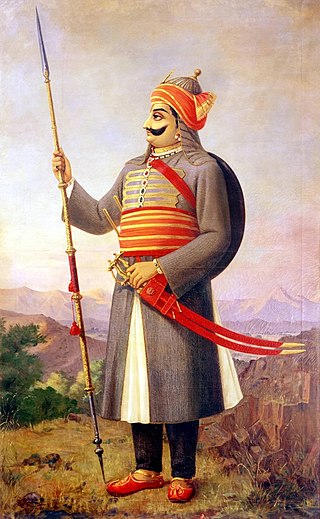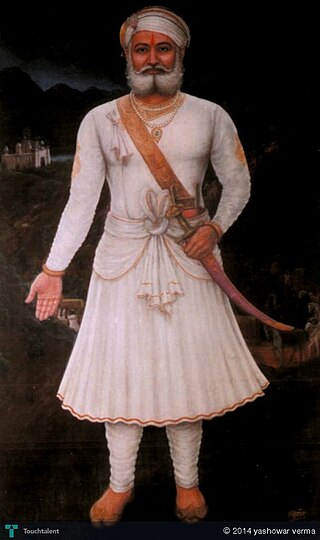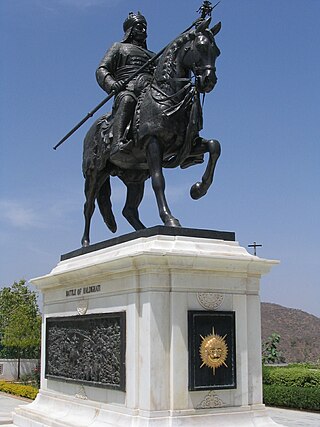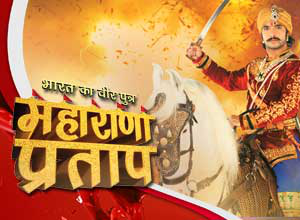
Pratap Singh I, popularly known as Maharana Pratap, was a king of Kingdom of Mewar, a princely state in north-western India in the present-day state of Rajasthan. He is notable for leading the Rajput resistance against the expansionist policy of the Mughal Emperor Akbar including the Battle of Haldighati.
Gogunda is a town and tehsil headquarters of Gogunda Tehsil in Udaipur district, located about 35 km (22 mi) in north-west from Udaipur city in the Indian state of Rajasthan. It is situated on a high mountain in Aravalli hills and is reached by crossing a difficult mountain pass.

Bhama Shah (1547–1600) was a noted general, minister and close aide of Maharana Pratap Singh. The financial support provided by him allowed Maharana Pratap to restore his army and reclaim much of his lost territory.

The battle of Haldighati was fought on 18 June 1576 between the Mewar forces led by Maharana Pratap, and the Mughal forces led by Man Singh I of Amber. The Mughals carried the day after inflicting significant casualties on Mewar forces, although they failed to capture Pratap, who reluctantly retreated persuaded by his fellow commanders.
Hakim Khan Sur An ethnic Pashtun, was a descendant of Sher Shah Suri and a general in Rana Pratap's army. He fought with him in the Battle of Haldighati and died in 1576. In Haldighati Battle, he commanded an army of Afghans who were against the rising power of Mughal Empire.

Chetak or Cetak is the name given in traditional literature to the horse ridden by Maharana Pratap at the Battle of Haldighati, fought on 18 June 1576 at Haldighati, in the Aravalli Mountains of Rajasthan, in western India.
Bhainsrorgarh Fort or Bhainsror Fort is an ancient fort that has become a major tourist spot in the state of Rajasthan, India.

City Palace, Udaipur is a palace complex situated in the city of Udaipur in the Indian state of Rajasthan. It was built over a period of nearly 400 years, with contributions from several rulers of the Mewar dynasty. Its construction began in 1553, started by Maharana Udai Singh II of the Sisodia Rajput family as he shifted his capital from the erstwhile Chittor to the newfound city of Udaipur. The palace is located on the east bank of Lake Pichola and has several palaces built within its complex.

Moti Magri is a hill in India. It overlooks the Fateh Sagar Lake in the city of Udaipur, Rajasthan.
Devi Garh Palace is a heritage hotel and resort, housed in the 18th-century Devi Garh palace in the village of Delwara. It was the royal residence of the rulers of Delwara principality, from the mid-18th century till the mid-20th century. Situated in the Aravalli hills, 28 km northeast of Udaipur, Rajasthan, Devigarh forms one of the three main passes into the valley of Udaipur.

Chetak Smarak, also called Chetak Samadhi, is a memorial to Maharana Pratap's famed steed Chetak, in the Indian state of Rajasthan. The horse died of battle wounds after helping the Rana effect a miraculous escape from the Battle of Haldighati. The memorial is said to have been built at the spot that Chetak died.
Bhinder or Bhindar is a town in Udaipur District, that is located 315 km (196 mi) from the state's main city Jaipur. Bhinder borders the Chittorgarh District in Rajasthan and is located 58 kilometres (36 mi) south-east of Udaipur. Notable tourist sites nearby include Sita Mata Wildlife Sanctuary, Jaisamand Sanctuary, and Jaisamand Lake. Bhinder is surrounded by four lakes.
The Mughal–Rajput wars were a series of battles between the Rajput Confederacy and the Mughal Empire. The conflicts originated with the invasion of northwestern India by the Mughal ruler Babur, to which the head of the Rajput confederacy, Rana Sanga, offered staunch resistance.

Maharana Pratap: The First Freedom Fighter is an Indian epic film based on Maharana Pratap of Mewar .The film is directed and produced by Dr. Pradeep Kumawat from Udaipur, Rajasthan. It is the first time that a film has been made on the history of Maharana Pratap. The film's sound track includes one of the last songs sung by Late Jagjit Singh.
Chawand is a town in Sarada tehsil of Udaipur district, Rajasthan. The historical significance of the town is that it was the last capital of Mewar under the reign of Maharana Pratap.

Bharat Ka Veer Putra – Maharana Pratap is an Indian historical fiction series produced by Contiloe Entertainment. It is based on the life of Maharana Pratap, a sixteenth century ruler of Mewar kingdom. It starred Sharad Malhotra, Rachana Parulkar, Faisal Khan and Roshni Walia.

Maharana Amar Singh I, the Maharana ruler of Mewar Kingdom, was the eldest son and successor of Maharana Pratap I.He was the 14th Rana of Mewar,ruling from January 19, 1597 till his death on January 26, 1620.
Shakti Singh Sisodia Mewar was the son of Maharana Udai Singh II Sisodia and Rani Sajja Bai Solanki. He was a Kshatriya Rajput and was younger brother of famous Maharana Pratap, He was also the eponymous founder of the Shaktawat clan of Sisodia Rajputs.

Shahbaz Khan's invasions of Mewar were the ongoing expeditions into Mewar by the Mughal forces of Shahbaz Khan Kamboh. The expansion of the Mughal Empire was initiated during the reign of Akbar the Great. This was notably evident in the Battle of Haldighati, where the Mewar forces suffered a futile defeat, compelling Rana Pratap to retreat to the hills. In the aftermath, multiple expeditions were dispatched to Mewar under the leadership of Shahbaz Khan Kamboh, ultimately leading to the permanent pacification of important territories like Mandalgarh, Kumbhalgarh, Gogunda, and Chittorgarh. These successful conquests culminated in the assimilation of Mewar into the Mughal Empire in 1615.












